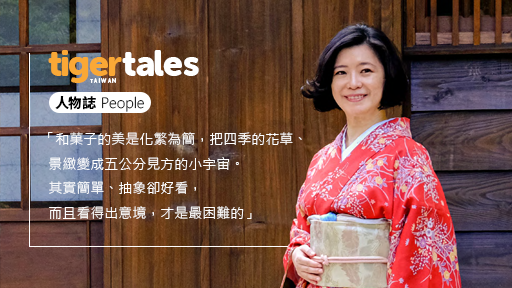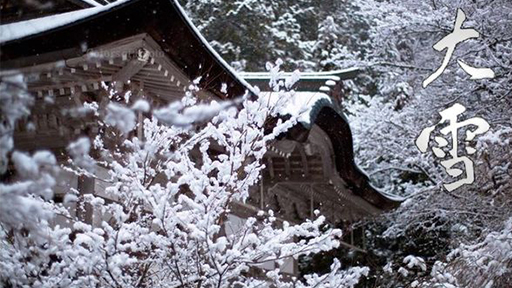
24節氣 12月-大雪
2023-12-06
24節氣 12月-冬至
2023-12-21文/邱立崴
圖/邱立崴攝、唐和家和菓子提供
和菓子能帶來人們的笑容:
和菓子職人ー吳蕙菁
Wagashi brings smiles to people’s faces:
Wagashi Master – Emily Wu
為了這次專訪,「唐和家和菓子」吳蕙菁老師特別商借了由日治時代官舍改裝的料亭「東美院」 作為拍攝地點。在和風滿溢的料亭裡,吳老師身著和服華麗登場。「和服是我的工作服」,她這麼說。從環境的選擇、示人的衣裝到她的和菓子,都表現出這位職人對「美」的堅持。
For this interview, Emily Wu, the owner and head chef of Toukaya, specially borrowed Thome Courtyard, a Japanese restaurant that was converted from a civil servant faculty housing building from Japanese rule era, as the shooting location. In the restaurant brimming with Japanese traditional atmosphere, Wu appeared in a gorgeous kimono. “Kimono is my work uniform,” she said. From the choice of the environment, the clothes she wears, to her wagashi, all revealed this master’s commitment to “beauty”.
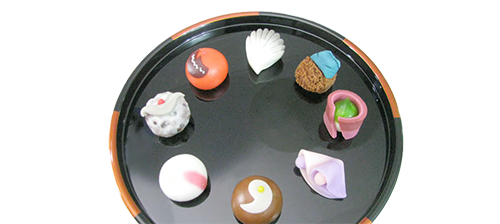
「電視冠軍」開啟了和菓子的大門
opened the door to wagashi
吳蕙菁原本從事平面設計。某天看到日本「電視冠軍」和菓子比賽裡造型精緻,色彩豐富,如同藝術品的「上生菓子」,讓她瞬間被吸了進去,難以忘懷。
後來遭遇到婚姻挫折,一方面是逃避,但另一方面也因此決心圓夢,年過 30 的她在日文只懂 50 音的程度下毅然飛往日本,向和菓子職人之夢邁出第一步。她從語言學校讀起,苦讀之下僅用 1 年就考上日檢 2 級,然後進入東京製菓學校。
Wu used to be a graphic designer. She was instantly drawn to the beauty of jo-namagashi, a delicate and colorful type of wagashi, when she saw it on the Japanese TV show “TV Champion”. After a divorce, Wu decided to pursue her dream of becoming a wagashi master. She flew to Japan after the age of 30, even though she only knew hiragana at the time. She started by attending a Japanese language school, and passed JLPT N2 level in just one year. She then enrolled in the Tokyo Confectionary School.
「菓子は人なり」
Kashi wa hito nari
製菓學校的同學幾乎全是小自己一輪,年少輕狂的小鬼。除了年齡和語言隔閡,整天站著做和菓子更是體力的負荷。但吳蕙菁樂觀地當自己重返 18 歲,放下身段迎接新環境的挑戰。和菓子雖深奧,但吳蕙菁卻擁有不少優勢。大學讀美術,從事設計的她擁有專業的美學素養,也擅長畫設計圖;而且許多和菓子專有名詞都是漢字,台灣人要理解記憶都很容易;另一個優勢則是天賦,她原本就手巧學得快,老師示範都看過一次就會,她不禁覺得與和菓子的緣分是命中注定。東京製菓學校的校歌第一句是「菓子は人なり」。歌詞的深意是:菓子會反映製作者的人格。同樣的材料,認真的人會做出精美的成品,隨便的人則會做出粗劣的成品。人必須真摯面對菓子,隨時間經過,菓子也會展現人的成長。在兩年職人教育洗禮下,吳蕙菁成為一個職人,也和原有著代溝的同學們成了切磋成長的夥伴。
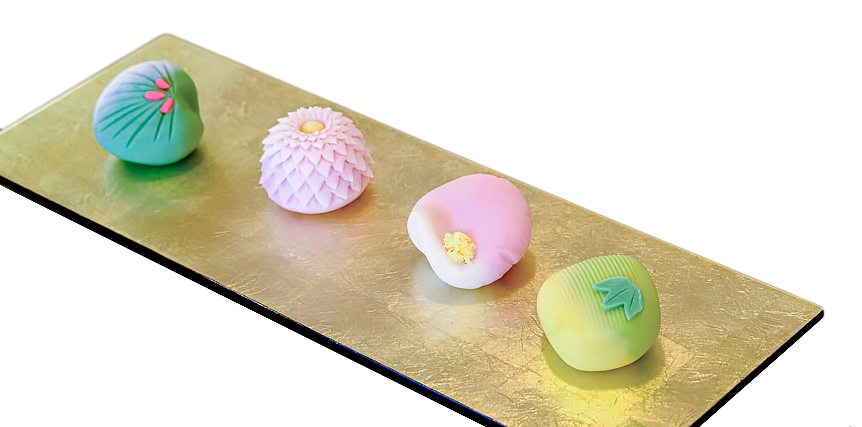

In Tokyo Confectionary School, she was surrounded by energetic brats who were more than 10 years younger than her. In addition for the age and language barriers, she also had to deal with the physical demands of standing all day for wagashi making. But Wu was determined and took on the challenge with a positive attitude, even pretending to be 18 again. Wagashi is a complex art form, but she also had a number of advantages. Wu had studied arts in college and worked as a designer; had a strong aesthetic sense and good at drawing design sketches. In addition, many of the wagashi terms are Kanji characters, so it is easy for Taiwanese people to understand and memorize. She was a quick learner and could do what her teacher demonstrated after seeing it once. She couldn’t help but feel that she was born to be a wagashi craftsman. The first line of the Tokyo Confectionary School’s school song is “Kashi wa hito nari”. The meaning of the lyrics is that wagashi reflects the personality
of the maker. With the same ingredients, a serious person will make a beautiful product, while a careless person will make a shoddy product. Wagashi needs to be made with sincerity. Over time, wagashi will also reflect the growth of the person. After two years of apprenticeship. Through the process of learning and exchanging ideas with classmates who she initially had generation gap issues with, she finally became a skilled professional.


吹進日本和菓子界的「台風」
The “Tai-phoon” blowing through
the Japanese wagashi world
2 年級時,老師帶吳蕙菁到阿佐谷的和菓子名店「兔子 屋(うさぎや)」觀摩。從廠長手中接過剛出爐的銅鑼燒,不僅暖進心裡,也激起她在此打工的念頭。日本傳統產業對外國人的態度較保守,但吳蕙菁憑一股傻勁,以及對和菓子率直的熱愛打動老闆娘,破例讓她當工讀生。
也是在 2 年級,吳蕙菁創下另一壯舉:以唯一的外國人 與學生身分參加「日本菓業振興會」的比賽。這項職業賽每月得交出 5 個作品,還須兼顧不同素材、色彩的平衡與季節感。為顧慮對全體學生的公平,學校不提供場地及資源供她練習,吳蕙菁在沒有外援,且課業、打工與比賽三頭燒之下堅持了 1 年,當真以和菓子菜鳥的身分在租屋處的小廚房裡完成一個又一個參賽作品。
吳蕙菁的熱情與才華讓兔子屋本想正式聘雇她,但工作簽證申請未過,讓她畢業後只能在眾人嘆息中返台。但皇天不負苦心人,歸國前夕她獲日本菓業振興會頒發「評審委員特別獎」,成為該比賽 80 年來首位外籍獲獎者。留日 2 年, 吳蕙菁得到的遠比當初期待的更多,甚至為日本菓業吹進了新風潮,一切彷彿日劇般的勵志情節。
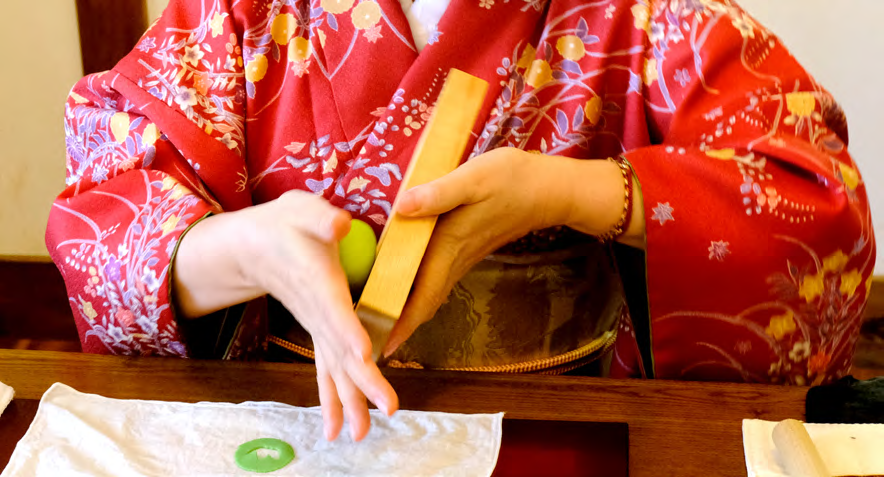
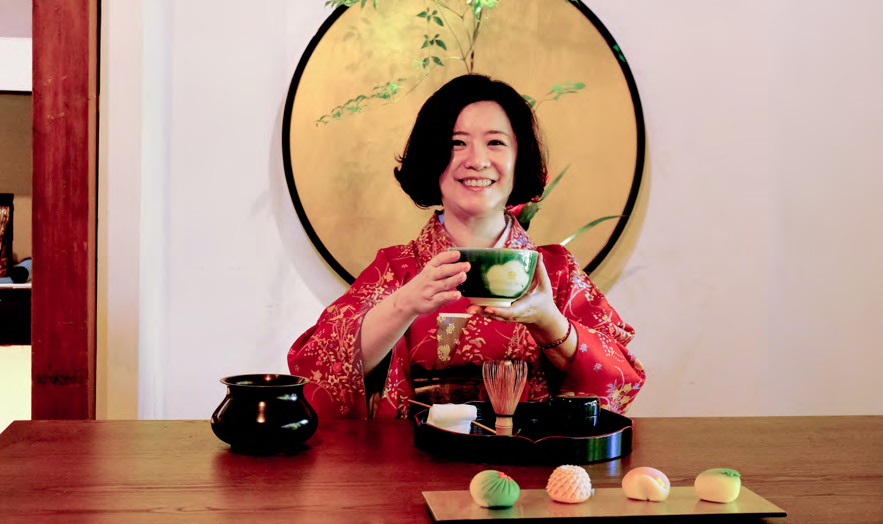
In her second year of school, Wu’s teacher took her to observe “Usagiya”, a famous wagashi shop in Asagaya. When she received a freshly baked Dorayaki from the shop manager, she not only felt warm in her heart, but also developed the idea of wanting to work there. Despite the traditional Japanese industry’s conservative attitude towards foreigners, Wu impressed the owner with her determination and passion for wagashi, and was allowed to work as a part-timer
In her second year, Wu also achieved another feat: she was the only foreigner and student to participate in the “Japan Confectionary Promotion Association” competition. The competition requires participants to submit five works each month, taking into account the balance of different materials, colors, and season. The school did not provide Wu with any resources or space to practice, as they wanted to be fair to all students. Wu persisted for one year, juggling her study, part-time job, and competition at the same time, and she completed one work after another in her tiny kitchen.
Wu’s passion and talent impressed the owner of Usagiya, who wanted to offer her a full-time position. However, her work visa application was denied, and she
had to return to Taiwan after graduation. But hard work pays off. Just before her departure, she was awarded the “Special Jury Prize” by the Japan Confectionary Promotion Association, becoming the first foreign winner of the competition in its 80-year history. During the two years in Japan, Wu achieved more than she could have ever imagined. She even brought a new wave to Japanese confectionery, with a story that is like something out of a Japanese drama.
抽象之中見四時
The four seasons
in the abstract
回台灣後,吳蕙菁創立了「唐和家和菓子」,不僅將這精緻的食品藝術帶進台灣,也對台灣人的美感帶來新的刺激。「台灣人的美是具象、複雜的,由困難見功力。但和菓子的美是化繁為簡,把四季的花草、景緻變成五公分見方的小宇宙。其實簡單、抽象卻好看,而且看得出意境,才是最困難的」,吳蕙菁說。隨著越來越多客製化訂單,包括 12生肖、三國人物、品牌形象、宗教供品,東西方節日等等,她總能做出一個個突破刻板印象,卻又一眼就能辨識出主題的和菓子。
供佛專用的「佛菓子」是吳蕙菁的得意作品。佛教供品在造型上忌諱出現具體的人或動物形象,這不只是美學,更關乎戒律,因此她以高難度的「剪菊」技巧剪出各色的九品蓮花,並在花心有著代表不同佛尊的梵文「種子字」。
採訪過程中,吳蕙菁也現場展示了手藝。她拿出隨身工具組以及用白豆沙和砂糖為原料的「練切」,僅僅 15 分鐘就做出了「雪松」、「寒梅」與「竹」三種不同主題的上生菓子,接著更秀出剪菊技法,10 分鐘就在談笑間剪出一顆華麗的「菊姬」,神乎其技。
After returning to Taiwan, Wu founded “Toukaya”, bringing this delicate confectionar y art to Taiwan and stimulating Taiwanese people’s aesthetic sense. “Taiwanese aesthetics are concrete and complex, and
mastery is seen through difficulty. But the beauty of wagashi is to simplify the complex, turning the flowers and scenery of the four seasons into a small universe of five cubic centimeters. In fact, it is the most difficult to be simple, abstract, and beautiful with visible artistic conceptualization”, Wu said. As her custom orders increased, including 12 zodiac signs, “Romance of the three kingdoms” characters, brand images, religious offerings, and various holidays, she was always able to create wagashi that broke through stereotypes, but could still be identified with the theme at a glance.


Wu’s signature work is “Buddha-gashi”, which is specifically used as offerings to Buddha. Buddhist offerings should avoid any concrete images of people or animals, which is not only a matter of aesthetics, but also a matter of religions discipline. Therefore, she uses the highly difficult “Hasamigiku” technique to cut out lotus flowers of various colors, with “bijakshara”, a Sanskrit character representing different Buddhas, at the heart of the flowers
During the interview, Wu also demonstrated her skills on the spot. She took out her portable tool kit and “nerikiri”, which is made from white bean paste and sugar.
In just 15 minutes, she created three jo-namagashi with the themes of “pine tree”, “plum blossom”, and “bamboo”. Then, she showed off her Hasamigiku technique, in just 10 minutes, cut out a luxurious “Kikuhime” while chatting. It was truly amazing
結語
Epilogue
除了製作、販售和菓子,吳蕙菁也將一路走來的故事和畢生所學寫成《揉美的力量》、《和菓子聖經》、《和菓子魔法書》等書,更開設課程,創立流派,致力於和菓
子文化的推廣,弟子遍布全台。吳蕙菁深信「和菓子能帶來人們的笑容」,這是和菓子最迷人的地方,她也期許自己能像和菓子,讓身邊的人都露出笑容。當年在人生的低
潮時,和菓子為她的人生重啟一個出口,如今她深信自己為更多的人創造入口。至於從那個入口能通往何方,端看每個人的內心。
In addition to making and selling wagashi, Wu wrote books about her story and her life’s work, such as “The Power of Kneading”, “Wagashi Bible”, and “Wagashi Magic Book”. She also opened courses and founded a school, dedicated to promoting wagashi culture, with disciples all over Taiwan. Wu believes the most charming part of wagashi is “wagashi can bring smiles to people’s face”, she also hopes that she can make everyone around her smile. Wagashi gave her a new outlet when life hit a low point. Now she has created an entrance for more people. As for where that entrance leads, it depends on each person’s will.



